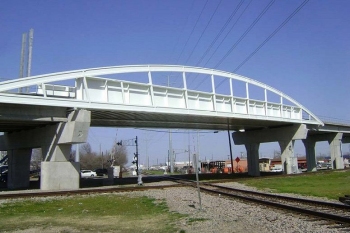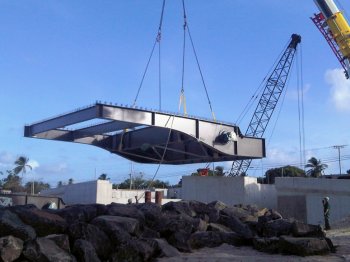Modelling with LUSAS Very early in the project Flint & Neill decided to create a shell element model of the whole cable stayed bridge structure in LUSAS. Peter Robinson, one of the projects engineers involved said, "Ordinary desktop computers are now capable of running a shell model of the entire bridge, which is great for modelling the distortional and shear lag stresses around the cable anchorages in wide boxes such as West Gate." A rigidity matrix was defined to model the orthotropic effect of the stiffened plates. Linear elastic analysis was used to allow load combinations to be assessed.
Loadcases considered For the permanent loadcase a survey carried out in 2007 showed that the central span of the bridge had deflected by around 330mm over the years due to the creep and sagging of the cables. Although the stretching of the cables didn't change the tensions in them very much it did add considerably to the stresses in the deck when sagging at mid-span and when hogging at the towers. In the LUSAS assessment model the initial stress in the cable stays was adjusted to represent creep and the deck profile was matched to that of the 2007 survey. An as-built profile was also modelled to allow re-tensioning of the cables in the future. For live loading, the traffic load definition was specific to West Gate Bridge and was derived from weigh-in-motion data where the weights of vehicles crossing the bridge were recorded and analysed to derive the extreme loading. Traffic loads were generated using Autoloader traffic load optimisation software which required the creation of over 700 traffic loadcases to assess maximum stress along the box girder, and in the bearings and cables. For wind loading static loadcases were derived from the gust buffeting response of a spine model. Because of the history of the bridge the handling of the construction loads was a particularly sensitive issue, made all the more difficult because the bridge was overstressed under the existing eight lane traffic loading. For reasons of safety, it was required to position concrete barriers along the bridge during the upgrade works which added considerable weight. It was decided to limit the loads during construction to the maximum theoretical 8 lane loading before the strengthening had started. This was achieved by modelling the full sequence of gantry movements and resulted in night time lane restrictions for a long period and restrictions on the allowable movements of gantries.
Detailed modelling Because Flint & Neill chose to create a shell element model of the whole bridge in LUSAS it was straightforward to refine the mesh in certain areas of interest to investigate localised effects. This had other benefits too as Peter Robinson explains: "Having a single global shell model meant that there was no need to worry about specifying boundary conditions or applying suitable loading as would be required for looking at regions of the structure using separate localised models, and this was a big plus." He continues: "The model also showed how the distribution of loads in the webs and diaphragms of the anchorages took place. It's worth pointing out that for the assessment carrying out the analysis with LUSAS was only half the story. We also had the task of checking against all the element (member) capacities which, for stiffened structures such as this box girder, can be very complex."
Codified checks were carried out to BD56 and to IDWR (Interim Design and Assessment Rules). These rules were drawn up in the 1970s following the collapse of bridges such as Milford Haven and West Gate Bridge and were felt by Flint & Neill to be the most appropriate assessment tool for the upgrade project. Localised modelling and nonlinear analysis with LUSAS was used to improve torsional buckling capacity of the bulb-flats beyond codified values resulting in a reduction of the strengthening required being obtained.
Strengthening required At the start of the strengthening project a lot of work was done to improve the access to the box girder. This saw the enlargement of the central reserve manholes, end pier soffit openings, internal walkways and of the diaphragm and inner web openings where possible. The outside of the bridge has seen the addition of 528 cantilever props, which were installed over a 12 month period using gantries slung beneath the cantilevers. Substantial strengthening was carried out inside the box to the bottom flange and webs. This took the form of extra stiffening to the existing stiffeners and the addition of some new stiffeners. The box walls and diaphragm around the pier bearings required heavy strengthening in an already congested area. Prestressing strands were also used inside the box girder to overcome tension overstress in the bottom flange plate and overstress at the splice plates. The prestressing extends over a 60m length of flange, passing through holes drilled in the flange stiffeners, with plated anchorages at each end. Additional stiffening of the towers was also required requiring the fitting of new plates in the region where the tower penetrates the deck level and for these close tolerance bolts were used to avoid weakening the existing structure.
Awards
Share this article
Find out more
Other LUSAS Bridge case studies:
|
|
Software Information
|
||||||||||||||||||||||||||||||||||||||||
|



















